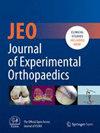Patient-specific versus off-the-shelf unicompartmental knee arthroplasty during level walking
Abstract
Purpose
Personalised unicompartmental knee arthroplasty (UKA) improves tibial implant positioning and clinical outcomes compared to an off-the-shelf UKA. However, no biomechanical study has confirmed the functional superiority of custom implants. The study aimed to assess potential differences between personalised and off-the-shelf UKA in knee joint function in terms of both biomechanical and clinical outcomes during level walking.
Methods
Twenty-two patients and 22 healthy individuals (control group [CG]), matched for age and height, were recruited. Eight patients were implanted with a Bodycad UKS (BUKS) prosthesis, and 14 patients with an Oxford UKA (OUKA) prosthesis. Participants walked barefoot along a 10 m walkway. To quantify 3D kinematics and kinetics, a 10-camera motion analysis system and four force plates were used. The knee injury and osteoarthritis outcome score (KOOS) was utilised to measure knee function. 3D lower limbs angles and moments were estimated, and total support moment (TSM) was calculated. Biomechanical outcomes were compared along the gait cycle (GC) (0%–100%) between groups using statistical parametric mapping (SPM).
Results
The results showed higher KOOS total score for BUKS compared to OUKA (p = 0.020, effect size [ES] = 0.62). No significant differences were observed between BUKS and OUKA for the biomechanical variables (p > 0.05). Significant decrease of knee extension angle for OUKA compared to CG between 27% and 46% of GC (p < 0.001) was observed. Knee moments showed a significant decrease for the external knee flexor moment for OUKA compared to CG between 55% and 76% of the stance phase (SP) (p < 0.001). A reduction of the contribution of the knee to the first peak of TSM was observed for both BUKS and OUKA compared to CG (p = 0.019, ES = 0.34).
Conclusions
BUKS patients demonstrated similar knee function compared to OUKA. OUKA group exhibited a protective mechanism by reducing the knee extension. Neither BUKS nor OUKA restored knee joint function comparable to a native knee, with compensation mechanism occurring through adjacent joints.
Level of Evidence
Level III.





 求助内容:
求助内容: 应助结果提醒方式:
应助结果提醒方式:


